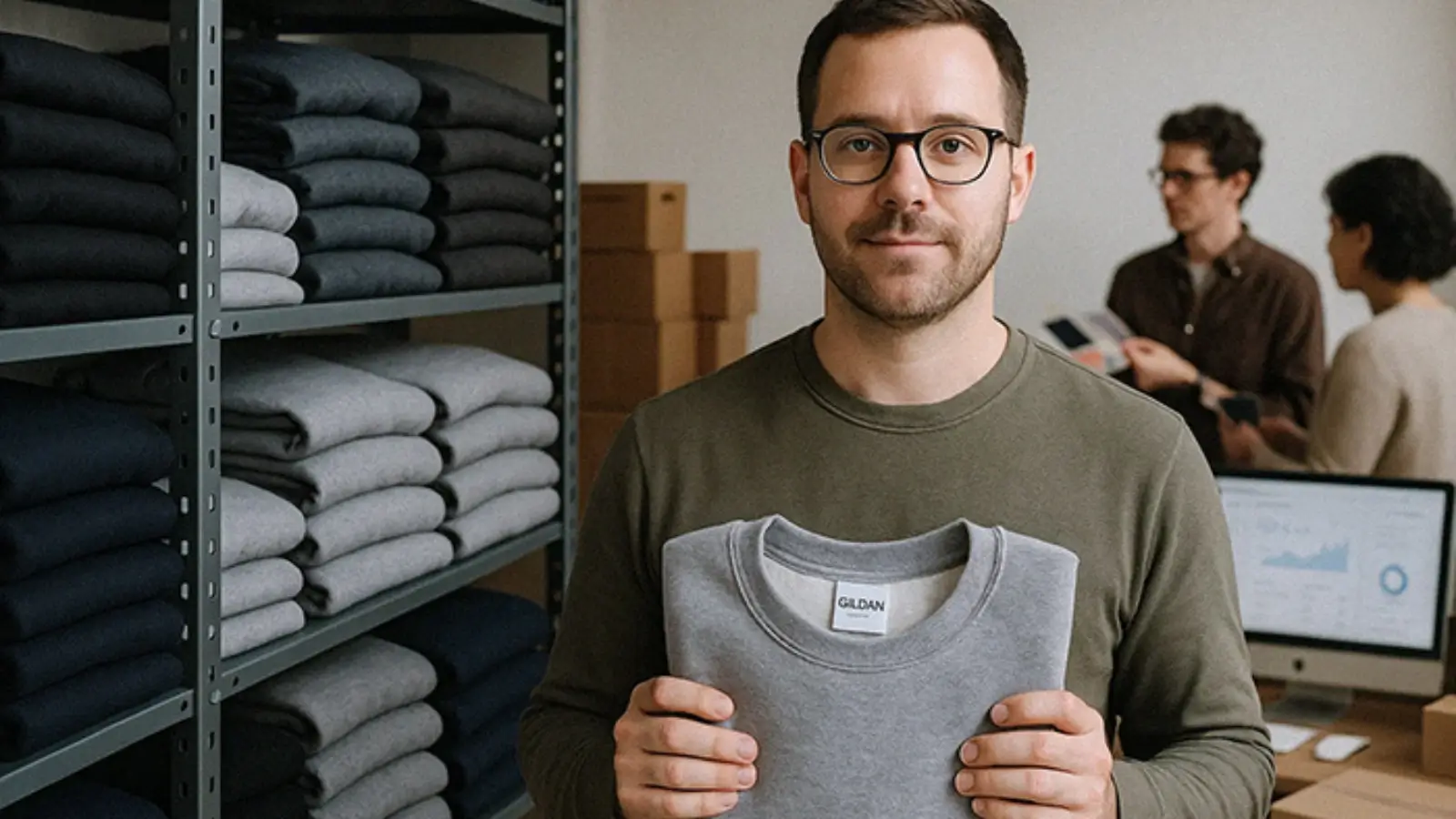


Starting a business with crewneck sweatshirts as the flagship product is surprisingly rewarding. Especially when you know how to make them captivating through customization. However, a more thought-about business idea lately is to launch a wholesale model sweatshirt business. This is due to the massive popularity of sweatshirts in America. They make great merchandise, promo items, corporate swag, and trade show outfits depending on the season.
Small business owners face this decision as they build their apparel ventures. Fashion startups often struggle with this choice because wholesale and retail models offer distinct advantages and challenges. If you are aware of the profit margins, operational requirements, and market positioning of both approaches, it makes it easier to decide.
Wholesale operations focus on volume sales to retailers, distributors, and other businesses. Your primary customers become store owners rather than individual consumers. To be feasible, this model typically requires minimum order quantities ranging from 50 to 500 units per transaction.
But crewneck sweatshirts wholesale pricing does offer cost advantages. Especially when you know which manufacturer you should be sourcing the sweatshirts from. Manufacturers like Gildan provide bulk pricing tiers that can reduce unit costs by 40-60% compared to retail prices. Saving here lets you maintain competitive pricing while preserving your profit margins.
The catch is that this model requires different operational capabilities. Firstly, you'll need warehouse space for inventory storage. And that’s a big inventory we are talking about. Larger shipments may complicate order fulfillment unless you get the logistics right. To offset this as much as possible, you will need to ensure excellent customer service. This customer service will be more about building B2B relationships rather than individual customers, which is obviously harder.
Payment terms in wholesale often extend 30-60 days. This can and most likely will affect cash flow management. However, larger order values can offset these extended payment periods. Overall, wholesale operations require strong vendor relationships and efficient logistics systems.
Retail operations sell directly to end consumers through various channels. A physical store might be the first thing that comes to your mind. But a more viable option for starters is e-Commerce and social media sales, with the latter being the most cost-effective. The retail model gives you complete control over pricing, branding, and customer experience.
Profit margins in retail typically exceed wholesale margins considerably - by 200% or can even go up to 400%. For example, a Gildan crewneck sweatshirt purchased at $8 wholesale might retail for $25-40. This pricing flexibility enables premium positioning and brand building opportunities. And that’s where the actual challenges lie.
But the bigger fish to fry here is customer relationships. Those make or break budding businesses. Customer relationships become more personal in retail operations. You get constant feedback from customers, positive and negative. Using this to improve products and services is how you should approach this. Meanwhile, the marketing efforts should focus on individual consumer behavior rather than purchasing patterns. Many startups make a mistake here.
Retail requires different skill sets and resources. Visual merchandising, customer service, and digital marketing become essential. Inventory management operates on smaller scales but demands more frequent restocking.
Capital requirements obviously differ significantly between models. Wholesale operations need larger initial investments for bulk inventory purchases. Retail businesses can start with smaller quantities and scale gradually.
Market positioning affects model choice. Premium brands often benefit from retail control over presentation and customer experience. Mass-market products may perform better through wholesale distribution networks.
Your target market should dictate your approach. B2B customers require different sales strategies than individual consumers. You need to play around your natural strengths and network connections.
Time investment varies between models. Wholesale relationships, once established, can provide consistent revenue streams. Retail operations require ongoing customer acquisition and retention efforts.
One major benefit of wholesale operations is the predictable order patterns, especially once you establish customer bases. However, seasonal fluctuations can mess things up for wholesale models. They can impact retail models too but it’s easier to work around. Also, retail operations offer flexibility in product testing and rapid market response. New designs can be introduced quickly without minimum order constraints.
Technology requirements vary between models too. Wholesale businesses need efficient order processing and inventory management systems. Retail operations require e-commerce platforms (a lot of which is available for a fee), payment processing, and customer relationship management tools.
Wholesale margins typically range from 50-100% markup over cost. A $10 wholesale crewneck might cost $5-7 to produce. Volume requirements offset lower per-unit profits.
Retail margins can reach 300-500% over wholesale costs. However, additional expenses include marketing, customer service, and individual shipping costs. These operational costs can reduce net profitability. In a nutshell, wholesale operations need higher volumes to achieve profitability. Retail businesses can reach profitability with fewer units sold.
Assess your available capital, time commitment, and business goals. Wholesale suits entrepreneurs with limited marketing experience but strong operational capabilities. Retail appeals to those with a vision and customer service skills.
Or you can go hybrid with an approach that combines both of these models. There are many businesses in America that started with one model and expanded into the other. Not all of them succeed though. But this approach maximizes market reach and revenue potential.
The best way to go about this is to test one model with small-scale operations before committing entirely. While doing this, you should be looking at key performance indicators (KPIs) like customer acquisition costs, lifetime value (CLV), and operational efficiency.
Both wholesale and retail models offer viable paths for crewneck sweatshirt businesses. Your choice depends on personal strengths, available resources, and market opportunities. Wholesale is comparably more stable without much complexity in operations. Retail offers higher profits and brand control but can frequently get complicated operationally.
Invest in marketing. Learn as you grow. And make sure the customers (be it businesses or individuals) get the attention, not their buying behavior.